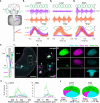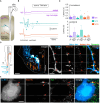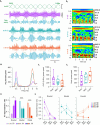Functional organization of vestibulospinal inputs responsible for tail postural control in larval Xenopus
- PMID: 39220733
- PMCID: PMC11361976
- DOI: 10.3389/fneur.2024.1439784
Functional organization of vestibulospinal inputs responsible for tail postural control in larval Xenopus
Abstract
In all vertebrates, maintaining trunk posture primarily depends on descending commands originating from brainstem vestibulospinal nuclei. Despite being broadly outlined across species, the detailed anatomical and operational structure of these vestibulospinal networks remains poorly understood. Xenopus frogs have previously served as an excellent model for exploring such anatomical and functional aspects in relation to the animal's behavioral requirements. In this study, we examined the reflex motor reactions induced by vestibular stimulation in pre-metamorphic tadpoles. Our findings indicate that natural vestibular stimulation in the horizontal plane yields greater efficacy compared to stimulation in other planes, a phenomenon replicated in a frequency-dependent manner through specific galvanic stimulation (GVS) of the horizontal semicircular canals. With the exception of a very rostral cluster of neurons that receive vestibular inputs and project to the spinal cord, the overall anatomical segregation of vestibulospinal nuclei in the brainstem mirrors that observed in juvenile frogs. However, our results suggest closer similarities to mammalian organization than previously acknowledged. Moreover, we demonstrated that vestibulospinal cells project not only to spinal motoneurons in rostral segments but also to more distal segments that undergo regression during metamorphosis. Lastly, we illustrated how vestibular-induced spinal reflexes change during larval development, transitioning from tail swim-based activity to rostral trunk bursting responses, likely anticipating postural control in post-metamorphic frogs.
Keywords: larval Xenopus; motoneuron; posture; spinal cord; vestibular.
Copyright © 2024 Barrios, Olechowski-Bessaguet, Pain, Bacqué-Cazenave, Cardoit, Cabirol, Le Ray and Lambert.
Conflict of interest statement
The authors declare that the research was conducted in the absence of any commercial or financial relationships that could be construed as a potential conflict of interest.
Figures








Similar articles
-
Functional organization of vestibulospinal inputs on thoracic motoneurons responsible for trunk postural control in Xenopus.J Physiol. 2020 Feb;598(4):817-838. doi: 10.1113/JP278599. Epub 2020 Feb 3. J Physiol. 2020. PMID: 31834949
-
Vestibular lesion-induced developmental plasticity in spinal locomotor networks during Xenopus laevis metamorphosis.PLoS One. 2013 Aug 12;8(8):e71013. doi: 10.1371/journal.pone.0071013. eCollection 2013. PLoS One. 2013. PMID: 23951071 Free PMC article.
-
Properties and axonal trajectories of posterior semicircular canal nerve-activated vestibulospinal neurons.Exp Brain Res. 2008 Nov;191(3):257-64. doi: 10.1007/s00221-008-1503-9. Epub 2008 Oct 2. Exp Brain Res. 2008. PMID: 18830591
-
Descending Influences on Vestibulospinal and Vestibulosympathetic Reflexes.Front Neurol. 2017 Mar 27;8:112. doi: 10.3389/fneur.2017.00112. eCollection 2017. Front Neurol. 2017. PMID: 28396651 Free PMC article. Review.
-
Otolith and canal integration on single vestibular neurons in cats.Exp Brain Res. 2005 Jul;164(3):271-85. doi: 10.1007/s00221-005-2341-7. Epub 2005 Jul 1. Exp Brain Res. 2005. PMID: 15991028 Review.
Cited by
-
Influence of semicircular canal morphology on the VOR and swimming activity in larval amphibians: a comparative study in Xenopus and axolotl.Front Neurol. 2025 May 19;16:1564585. doi: 10.3389/fneur.2025.1564585. eCollection 2025. Front Neurol. 2025. PMID: 40458463 Free PMC article.
References
-
- Agid Y. De la posture à l’initiation du mouvement. Rev Neurol. (1990) 146:536–42. - PubMed
LinkOut - more resources
Full Text Sources

